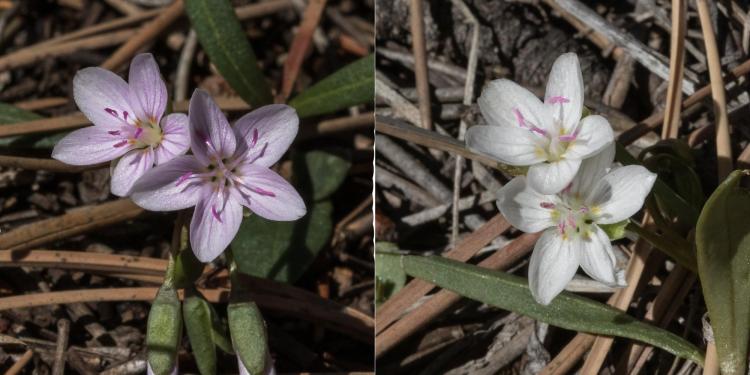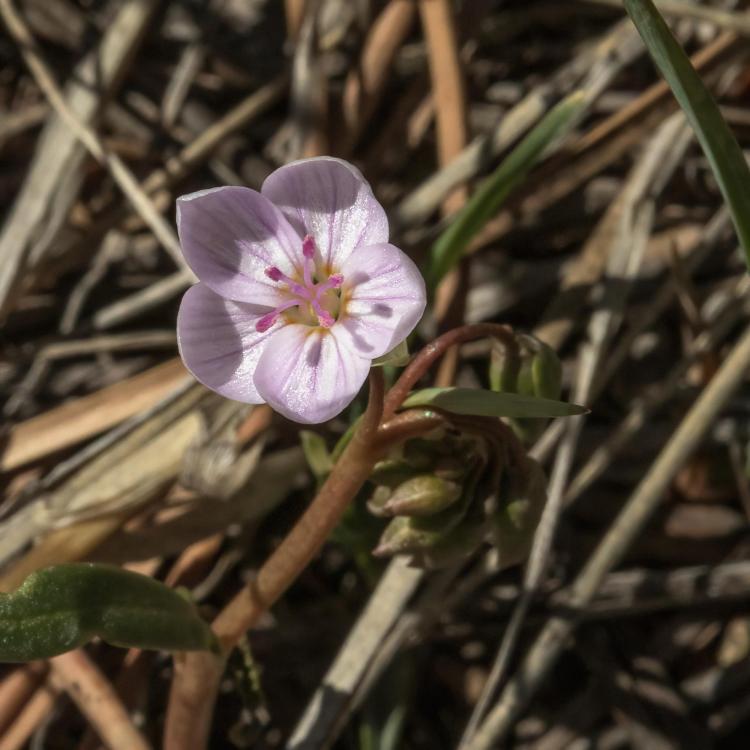Why are pink spring beauties varying shades of pink?
Pink spring beauties are ephemerals that sustained the earliest Americans, and selection pressure may hold the clue to color variation
Pink or Rocky Mountain spring beauties, Claytonia rosea, were blooming early in May on Flagstaff Mountain. Slender stems 3 to 6 inches tall were topped with one or two flowers 1/4th to 3/4th inches wide. Each flower had a three-parted style, five pink anthers and five petals, usually with pink veins. C. rosea is most commonly found in stands of ponderosa pines.
Pink spring beauty is a perennial and a spring ephemeral, one of the early wildflowers, but its flowers only last about two weeks. After this brief appearance, it dies back to its root, which is a round tuber 1 to 4 inches long.
A tuber (underground, a modified stem) and a bulb (underground, modified leaves) are similar in that they store energy gained by photosynthesis. But from the perspective of hungry people, the bulb of an onion and the tuber of a potato are both edible.

Pink spring beauties come in a variety of shades of pink and white. Photos by Jeff Mitton.
Because Native Americans relied on the bulbs of blue camas and several species of onions and several species of mariposa lilies, I wondered whether spring beauties also sustained Native Americans.
A digital search led me to a paper by James B. Benedict, known for his work on campsites, hearths, hunting blinds, game drives, stone tools, ceramics and diets of Paleoindians, starting with Clovis and Folsom peoples in the Colorado Front Range.
He listed three species of spring beauty used by Paleoindians here: pink spring beauty (C. rosea), alpine spring beauty (C. megarhiza) and western spring beauty, also called Indian potato (C. lanceolata). The tuber of C. lanceolata is almost round and up to 1 inch in diameter.
The flowers of these species are similar, all appear early in spring, and C. lanceolata and C. megarhiza flower just a few days after snowmelt in the subalpine and alpine tundra. So the bright flowers and reliable flowering times mark food for Paleoindians.
From both its Latin binomial, C. rosea, and its common name, pink spring beauty, one would infer that its flowers were pink. But that is not the full story. Background colors of the petals ranges from white to pink, and veins on the petals range from white through all intensities of pink.
The petals have blotches of yellow at their bases. The anthers are always pink, but the stamen filaments are either white or pink. This variation in color might mean nothing at all, or it could play an important role in the ecology of the plant.
It is a bit unusual to find flower color variation within a population—floral color variation is more frequently reported among populations. I could find nothing about flower color variation in C. rosea, but there has been a study of similar variation in C. virginica.
The Virginia spring beauty, C. virginica, is probably most unusual for its chromosomal variation, for while all C. roseahave eight chromosomes, more than 50 different chromosomal numbers have been reported in C. virginica.
But it is also known for Frank M. Frey’s careful and thorough study of floral colors, genes underlying the colors, other impacts of the genes influencing colors, and forms of natural selection imposed by pollinators, fungi and herbivores.

Pink spring beauties in darker shades of pink produce more seeds. Photos by Jeff Mitton.
C. virginica has four floral color morphs, ranging from nearly white to bright pink. These color forms are produced by a crimson pigment, cyanidin and two flavonols (quercetin and kaempferol). High levels of cyanidin increase the intensity of pink, and conversely high levels of flavonols are associated with white flowers. The flavonols have other consequences as well; they defend plants against fungi and herbivores.
Pollinators prefer deeply pink flowers, so the plants with pink flowers produce more seeds. If this were the only impact on the reproductive success of C. virginica, then plants with lighter flower colors would disappear and all C. virginica plants would have the deepest pink flowers.
Fungal infections and the level of leaf damage imposed by herbivores varied considerably among years, but when damage from fungi or herbivores was high, deep pink flowers suffered the greatest level of damage.
Note that pollinators favored pink flowers, while herbivores and fungi damaged pink flowers most. These effects form selection pressures, and the important point here is that the pressures push the floral colors in opposite directions.
Opposing selection pressures, if balanced just so, maintain genetic variation within populations. These forces are sufficient to explain the striking range of flower colors within populations of C virginica.
The flower color variation within the C. rosea population on Flagstaff Mountain struck me as odd. And while I cannot assert that the explanation is the same as in C. virginica, we now have a viable hypothesis for the maintenance of color variation in C. rosea.

